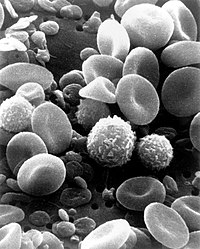
Photo from wikipedia
ABSTRACT Sepsis is a highly prevalent cause of death in intensive care units. Characterized by severe immune cell derangements, sepsis is often associated with multiorgan dysfunction. For many sepsis survivors,… Click to show full abstract
ABSTRACT Sepsis is a highly prevalent cause of death in intensive care units. Characterized by severe immune cell derangements, sepsis is often associated with multiorgan dysfunction. For many sepsis survivors, these deficits can persist long after clinical resolution of the underlying infection. Although many studies report on the impact of sepsis on individual immune cell subtypes, a comprehensive analysis of sepsis-induced alterations within and across the immune cell landscape is lacking. In this study, we used single-cell RNA sequencing to assess sepsis-associated transcriptional changes in immune cells isolated from bone marrow at single-cell resolution. We used a high-survival fecal-induced peritonitis sepsis model using Friend leukemia virus B mice. Single-cell RNA sequencing classified 3402 single cells from control subjects into 14 clusters representing long-term hematopoietic stem cell (HSC), short-term HSC, basophil, dendritic cell, eosinophil, erythroblast, erythrocyte, macrophage, neutrophil, natural killer cell, plasma cell, plasmacytoid dendritic cell, pre-B cell, and T memory cell lineages. One day following experimentally induced sepsis, cell type compositions shifted significantly and included notable decreases in HSC and myeloid cell abundance. In addition to proportional cell composition changes, acute sepsis induced significant transcriptional alterations in most immune cell types analyzed—changes that failed to completely resolve 1 month after sepsis. Taken together, we report widespread and persistent transcriptional changes in diverse immune cells in response to polymicrobial infection. This study will serve as a valuable resource for future work investigating acute and/or long-term sepsis-associated immune cell derangements.
Journal Title: Shock
Year Published: 2022
Link to full text (if available)
Share on Social Media: Sign Up to like & get
recommendations!